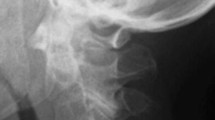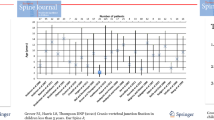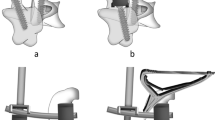Abstract
Background
According to Menezes’ algorithm, pre-operative dynamic neuroradiological investigation in C1–C2 dislocations (C1C2D) instability is strongly advocated in order to exclude those patients not eligible for posterior fixation and fusion without previous anterior trans-oral decompression. Anterior irreducible compression due to C1C2D instability, it is said, needs trans-oral anterior decompression. We reviewed our experience in order to refute such a paradigm.
Methods
The study involves 23 patients who were operated on for cranio-vertebral junction (CVJ) instability; all of them had C1C2D of varying degree on x-ray, computerised tomography (CT) and magnetic resonance (MR) imaging of the CVJ. Pre-operatively, irreducible C1C2D was demonstrated only in 3 patients, (2 with Down’s Syndrome, one of them was harbouring os odontoideum, 1 Rheumatoid Arthritis), i.e. 13.04%; the remaining 19 (86.9%) had reducible C1–C2 dislocation. After an unsuccessful traction test conducted in the pre-operative phase under sedation, it was possible to completely reduce the C1C2D (with a combination of axial traction with light extension of the neck on the chest and a light flexion of the head on the neck by using a Mayfield head holder) and proceed to posterior fixation in all the patients under general anaesthesia using a precise “timing sequences fixation technique”. Wiring (C0 and C3 were fixed first being stretched up to approximately 10 lbs, then C2 in order to pull up this vertebra last by forcing approximately 8 lbs) or screw fixation methods were used to achieve fusion along with post-operative external orthosis and neuroradiological assessment of the C1C2D. The instrumentation produced a lever and pulley effect which assisted reduction of the dislocation.
Findings
At follow up (range 34–55 months-mean 45.33 months) the clinical picture was improved or stable in all patients.
Conclusions
Pre-operative irreducibility of the C1C2D should not be an absolute indication for trans-oral decompression. An attempt to reduce the dislocation under general anaesthesia and during posterior fixation should be attempted in Down’s syndrome, os odontoideum and rheumatoid arthritis.



Similar content being viewed by others
References
Levi ADO (1998) Neurological syndromes of the cranio-vertebral junction instability. In: Dickman CA, Spetzler RF, Sonntag VHK (eds) Surgery of the cranio-vertebral junction. Thieme, New York, pp 103–120
Agarwal AK, Peppelman WC, Kraus DR (1992) Recurrence of cervical spine instability in rheumatoid arthritis following previous fusion: can disease progression be prevented by early surgery? J Rheumatol 19(9):1364–1370
Menezes AH (1998) Embryology, development and classification of the cranio-vertebral junction. In: Dickman CA, Spetzler RF, Sonntag VHK (eds) Surgery of the cranio-vertebral junction. Thieme, New York, pp 3–12
American Academy of Paediatrics. Committee on Sports Medicine (1984) Atlanto-axial instability in Down’s syndrome. Paediatrics 74(1):152–154
Ashraf J, Crokard HA, Ransford AO (1991) Trans-oral decompression and posterior stabilisation in Morquio’s disease. Arch Dis Child 66:1318–1321. doi:10.1136/adc.66.11.1318
Auden SM (1999) Cervical Spine Instability and dwarfism: fibreoptic intubation for all. Anaesthesiology 91:580
Bailey DK (1952) The normal cervical spine in infants and children. Radiology 59(5):712–719
Brandom BW (2002) Fine GF Neuromuscular blocking drugs in paediatric anaesthesia. Anesthesiol Clin North America 20:45–48. doi:10.1016/S0889-8537(03)00054-3
Brockmeyer DL, Apfelbaum RI (1999) A new occipito-cervical fusion construct in paediatric patients with occipito-cervical instability. Technical note. J Neurosurg 90(2 Suppl):271–5
Brockmeyer DL, Yok JE, Apfelbaum RI (2000) Anatomical suitability of C1-2 trans-articular screw placement in paediatric patients. J Neurosurg 92(1 Suppl):7–11
Brooks AL, Jenkins EB (1978) Atlanto-axial arthrodesis by the wedge compression method. J Bone Joint Surg 60:279–284
Cahill DG (2000) Re: posterior occipito-cervical reconstruction using cervical pedicle screw and plate–rod systems. Spine 25(10):1318
Chirossel JP, Passagia JG, Gay E, Palombi O (2000) Management of cranio-cervical junction dislocation. Childs Nerv Syst 16:697–701. doi:10.1007/s003810000324
Conlon PW, Isadale IC, Rose BS (1966) Rheumatoid arthritis of the cervical spine—An analysis of 333 cases. Ann Rheum Dis 25(2):120–126
Crockard HA, Stevens JM (1995) Cranio-vertebral junction anomalies in inherited disorders: part of the syndrome or caused by the disorders? Eur J Pediatr 154(7):504–512. doi:10.1007/BF02074823
Currarino G (2002) Segmentation defect in the mid-odontoid process and its possible relationship to the congenital type of os odontoideum. Pediatr Radiol 32:34–40. doi:10.1007/s00247-001-0579-1
Di Lorenzo N (1992) Cranio-cervical junction malformation treated by trans-oral approach. A survey of 25 cases with emphasis on post-operative instability and outcome. Acta Neurochir (Wien) 118(3–4):112–116. doi:10.1007/BF01401296
Diaz JH, Belani KG (1993) Peri-operative management of children with muco-polysaccharidoses. Anesth Analg 77:1261–1270. doi:10.1213/00000539-199312000-00028
Dickman CA, Sonntag VHK, Papadopulos SM (1991) The interspinous method of posterior atlanto-axial arthrodesis. J Neurosurg 74:190–198
Dickman CA (1998) Occipito-cervical wiring techniques. In Surgery of the cranio-vertebral junction. Thieme, New York, pp 795–808
Dvorak J, Grob D, Baumgartner H, Gschwend N, Grauer W, Larsson S (1989) Functional evaluation of the spinal cord by MRI in patients with rheumatoid arthritis and instability of upper cervical spine. Spine 14(10):1057–1064. doi:10.1097/00007632-198910000-00006
Fielding JW, Hensinger RN, Hawkins RJ (1980) os odontoideum. J Bone Joint Surg Am 62(3):376–383
Fielding JW (1988) The status of arthrodesis in the cervical spine. J Bone Joint Surg Am 70(10):1571–1574
Frankel HC, Hancock DO, Hyslop G (1969) The value of postural reduction in the initial management of closed injures of the spine with paraplegia and tetraplegia. Paraplegia 7:179–193
Gallie WE (1937) Skeletal traction in the treatment of fractures and dislocation of the spine. Ann Surg 106(4):770–776
Gluf WM, Brockmeyer DL (2005) Atlanto-axial trans-articular screw fixation: a review of surgical indications, fusion rate, complications and lessons learned in 67 paediatric patients. J Neurosurg Spine 2:164–169
Goel A, Kulkarni AG, Sharma P (2005) Reduction of fixed atlanto-axial dislocation in 24 cases: technical note. J Neurosurg Spine 2(4):505–509
Grob D, Dvorak J, Panjabi MM, Antinnes JA (1994) The role of plate and screw fixation in occipito-cervical fusion in rheumatoid arthritis. Spine 19(22):2545–2551
Grob D, Dvorak J, Panjabi M, Froehlich M, Hayek J (1991) Posterior occipito-cervical fusion. A preliminary report of a new technique. Spine 16(3 suppl):S17–24
Grob D, Janneret B, Aebi M, Markwalder TM (1991) Atlanto-axial fusion with trans-articular screw fixation. J Bone Joint Surg Br 73(6):972–976
Grob D (1999) Occipito-cervical fusion in patients with rheumatoid arthritis. Clin Orthop Relat Res 366:46–53. doi:10.1097/00003086-199909000-00007
Hensinger RN (1991) Congenital anomalies of the cervical spine. Clin Orthop Relar Res 264:16–38
Konttinen YT, Santavirta S, Gronblad M (1990) A retrospective clinical neuro-immuno-histochemical study of rheumatoid arthritic patients with atlanto–axial subluxation. Scand J Rheumatol 19(1):43–49. doi:10.3109/03009749009092620
Larsson SE, Toolanen G (1986) Posterior fusion for atlanto–axial subluxation in rheumatoid arthritis. Spine 11(6):525–530. doi:10.1097/00007632-198607000-00004
Lipson SJ (1977) Fractures of the atlas associated with fractures of the odontoid process and transverse ligamentum ruptures. J Bone Joint Surg Am 59(7):940–943
Magerl F, Seemann PS (1987) Stable posterior fusion of the atlas and axis by trans-articular screw fixation. In: Kehr P, Weidner A (eds) Cervical Spine I. Springer-Verlag, New York, NY, pp 322–327
Magerl F, Seman PS (1987) Stable posterior fusion of the atlas and axis by trans-articular screw fixation. In: Kehr P (ed) Cervical Spine. Springer Werlag, New York, pp 322–327
Marcotte P, Dickman CA, Sonntag VHK (1993) Posterior atlanto-axial facet screw fixation. J Neurosurg 79:234–237
Marks JS, Sharp J (1981) Rheumatoid cervical myelopathy. QJ Med 50(199):307–319
Mathews JA (1974) Atlanto–axial subluxation in rheumatoid arthritis. A 5–year follow study. Ann Rheum Dis 33(6):526–531. doi:10.1136/ard.33.6.526
Menezes AH, Ryken TC (1992) Cranio-vertebral abnormalities in Down’s syndrome. Pediatr Neurosurg 18(1):24–33. doi:10.1159/000120638
Menezes AH, Van Gilder JC, Cr C (1985) Odontoid upward migration in rheumatoid arthritis: an analysis of 45 patients with cranial settling. J Neurosurg 63:500–509
Menezes AH (1996) Rheumatological disorders. In Principles of spinal surgery. Mc Graw Hill, New York, pp 705–722
Menezes AH (1994) Occipito-cervical fusion: indications, technique and avoidance of complications. In: Hitchon PW (ed) Techniques of spinal fusion and stabilisation. Thieme, New York, pp 82–91
Menezes AH (1996) Posterior occipital C1–C2 fusion. In Principles of spinal surgery. Mc Graw Hill, New York, pp 1051–1065
Meyer B, Vieweg U, Rao JG, Stoffel M, Schramm J (2001) Surgery for upper cervical spine instabilities in children. Acta Neuroch (Wien) 143(8):759–765 discussion 765–6
Michejda M, Menolascino F (1975) Skull base abnormalities in Down’s syndrome. Ment Retard 13(1):24–26
Oda I, Abumi K, Sell LC, Haggerty CJ, Cunningham BW, Mc Afee PC (1999) Biomechanical evaluation of five different occipito-atlanto-axial fixation techniques. Spine 24:2377–2382. doi:10.1097/00007632-199911150-00015
Pouliquen JC, Pennecot GF, Beneux J, Chadoutaud F, Lacert P, Duval-Beaupere G, Durand J (1982) Cranio-vertebral junction and Morquio disease. A propose of 6 cases. Chir PAediatr 23(4):247–255
Reilly CW, Choit RL (2006) Trans-articular screws in the management of C1–C2 instability in children. J Pediatr Orthop 26:582–588
Ricciardi JE, Kaufer H, Louis DS (1976) Acquired os odontoideum following acute ligament injury. Report of a case. J Bone Joint Surg Am 58(3):410–412
Rogers MA, Crockard HA, Moskovitz R (1994) Nystagmus and joint position sense: their importance in posterior occipito-cervical fusion in rheumatoid arthritis. Spine 19(1):16–20. doi:10.1097/00007632-199401000-00004
Ryken TC, Menezes AH (1995) Abnormalities of the cranio-vertebral junction in Down’s syndrome. In Principles of spinal surgery. Mc Graw Hill, New York, pp 395–409
Sahin A, Salman MA, Erden IA, Aypar U (2004) Upper cervical vertebrae movement during intubating laryngeal mask, fibreoptic and direct laryngoscopy: a video-fluoroscopic study. Eur J Anaesthesiol 21(10):819–23
Salunke P, Behari S, Kirankmar MV, Sharma MS, Jaiswal AK, Jain VK (2006) Paediatric congenital atlanto-axial dislocation: differences between the irreducible and reducible varieties. J Neurosurg 104(2 suppl):115–122
Segal LE, Drummond DS, Zanotti RM (1991) Complications of posterior arthrodesis of the cervical spine in patients who have Down’s syndrome. J Bone Joint Surg Am 73:1547–1554
Selcuk M, Celebioglu B, Celiker V, Basgul E, Aypar U (2005) Infusion and bolus administration of cisatracurium-effects on histamine release. Middle East J Anesthesiol 18(2):407–419
Sherk H, Nicholson J, Chung S (1978) Fractures of the odontoid process in young children. J Bone Joint Surg Am 60(7):921–924
Sherman L (1994) The cranio-vertebral junction in Rao KCVG. In MRI and CT of the spine. Williams & Wilkins, Baltimore, pp 71–97
SIAARTI Study GroupDifficult Airway (2005) Recommendations for airway control and difficult airway management. Minerva Anestesiol 71:617–657
SIAARTI Study GroupDifficult Airway (2006) Recommendations for airway control and difficult airway management in paediatric patients. Minerva Anestesiol 72:723–748
Smith MD, Anderson P, Grady MS (1993) Occipito-cervical arthrodesis using contoured plate fixation, an early report on a versatile fixation technique. Spine 18(14):1984–1990
Smoker WR (1994) Cranio-vertebral junction: Normal anatomy, craniometry and congenital anomalies. Radiographics 14(2):255–277
Sonntag WHK, Dickman CA (1996) Posterior occipital C1–C2 instrumentation. In: Menezes AH (ed) Principles of spinal surgery. Mc Graw Hill, New York, pp 1067–1079
Spitzer R, Rabinowith JY, Wibar KC (1961) A studies of the abnormalities of the skull, teeth, and lenses in mongolism. Can Med Assoc J 84:567–572
Stevens JM, Kendall BE, Crokard HA (1991) The odontoid process in Morquio–Brailsford’s disease. The effects of occipito-cervical fusion. J Bone Joint Surg Br 73:851–858
Subin B, Liu JF, Marshall GJ, Huang HY, Ou JH, Xu GZ (1995) Trans-oral anterior decompression and fusion of chronic irreducible atlanto-axial dislocation with spinal cord compression. Spine 20(11):1233–1240
Taggard DA, Menezes AH, Rycken TC (2000) Treatment of Down’s syndrome–associated cranio-vertebral junction abnormalities. J Neurosurg 93(2 suppl):205–213
Tippets RH, Alvis MA (1996) Treatment of axis fractures. In: Menezes AH, Sonntag VHK (eds) Principles of Spinal Surgery. Mc Graw Hill, New York, pp 871–883
Vale E (1999) Rigid occipito-cervical fusion. J Neurosurg 91(2 suppl):144–150
Visocchi M, Cabezas Cuevas D, Di Rocco C, Meglio M (2001) Cranio-cervical instability, instrumentation and fusion: personal experience with contoured titanium bar and sublaminar wires. GAJ Mc Culloch, PL Reilly (Eds): Proceedings of the World Federation of Neurosurgical Societies 12th World Congress of Neurosurgery. Sidney Australia pp 279–283
Visocchi M, Di Rocco F, Meglio M (2003) Cranio-cervical junction instability: instrumentation and fusion with titanium rods and sublaminar wires. Effectiveness and failures in personal experience. Acta Neurochir (Wien) 145:265–272. doi:10.1007/s00701-002-1067-6
Weissman BN, Aliabadi P, Weinfeld MS, Thomas WH, Sosman JL (1982) Prognostic features of atlanto-axial subluxation in rheumatoid arthritis patients. Radiology 144(4):745–751
Wang C, Yan M, Zhou HT, Wang SL, Dang GT (2006) Open reduction of irreducible atlanto-axial dislocation by trans-oral anterior atlanto-axial release and posterior internal fixation. Spine 31(11):E306–13
White PM (1990) Kinematics of the spine. In: White AA (ed) Clinical Biomechanics of the spine. JB Lippincot, Philadelphia, pp 85–126
Yin Q, Ai F, Zhang K, Chang Y, Xia H, Wu Z, Quan R, Mai X, Liu J (2005) Irreducible anterior atlanto-axial dislocation: one-stage treatment with a trans-oral atlanto-axial reduction plate fixation and fusion. Report of 5 cases and review of the literature. Spine 30(13):E375–81
Author information
Authors and Affiliations
Corresponding author
Additional information
Comment
This study presents three cases of surgical treatment due to CVJ instability; all the three patients were diagnosed with irreducible C1–C2 dislocation. Under light sedation all the patients underwent a traction test in the preoperative phase. None of the patients showed a reduction of the shift. In such cases a number of authors recommend that anterior transoral decompression be carried out, which includes the following steps: removal of the dens as well as callus, granulation, and scar tissue, excision of the cartilage of the articular surfaces of the atlantoaxial joints, and occipitocervical fixation via anterior or posterior access.
The authors have identified a method that will save the patient this burdening phase of treatment. In their three cases the C1–C2 dislocation, although irreducible preoperatively and under traction, became reducible under general anesthesia, curarization and posterior fixation by using a precise “timing sequences fixation technique”. In these cases the instrumentation produced a lever effect with a pulley-like mechanism which forced the reduction of the CVJ complex. Early and long-term outcome of treatment in all three cases was satisfactory while the routine x-ray check-up revealed good decompression of neural structures and proper positioning of the C1/C2 complex.
Mariusz Maliszewski
Silesian University of Medicine, Sosnowiec, Poland
Rights and permissions
About this article
Cite this article
Visocchi, M., Pietrini, D., Tufo, T. et al. Pre-operative irreducible C1–C2 dislocations: intra-operative reduction and posterior fixation. The “always posterior strategy”. Acta Neurochir 151, 551–560 (2009). https://doi.org/10.1007/s00701-009-0271-z
Received:
Accepted:
Published:
Issue Date:
DOI: https://doi.org/10.1007/s00701-009-0271-z




